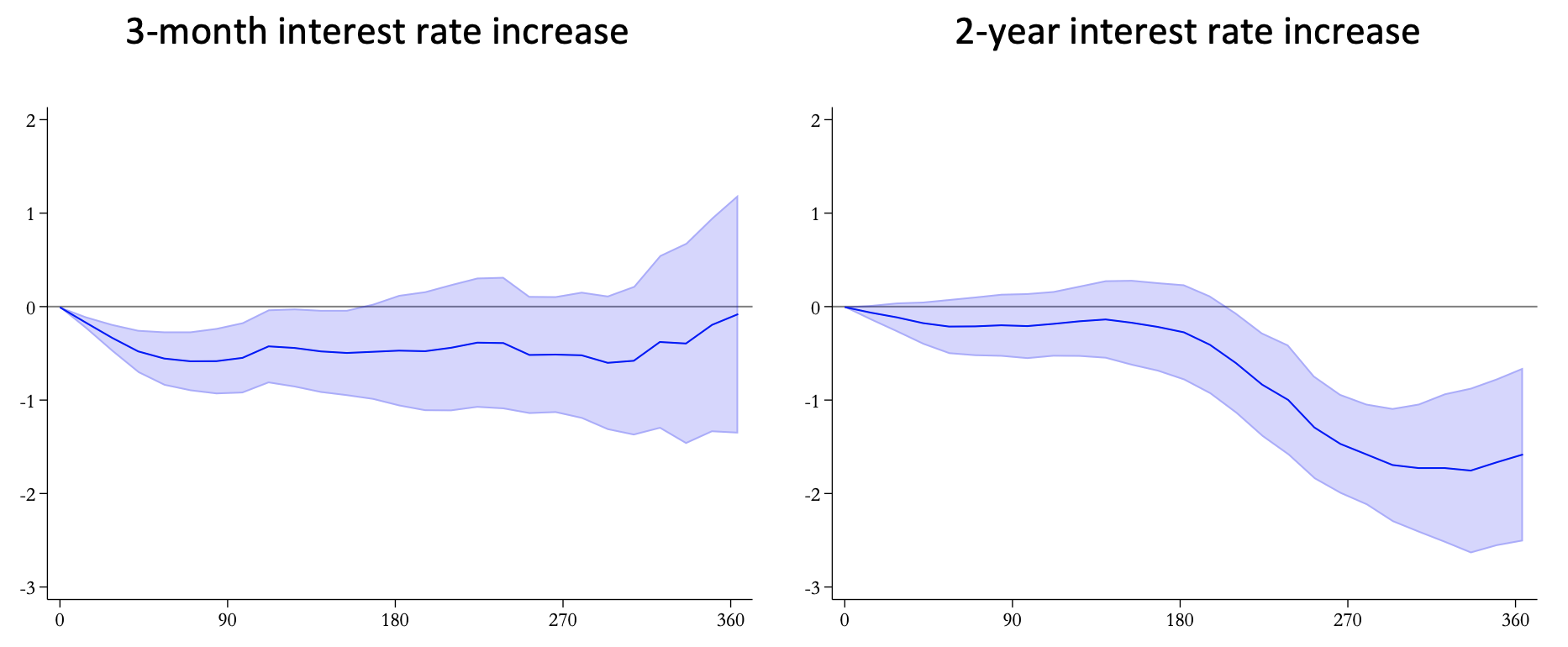The global increase in inflation after the COVID-19 pandemic has prompted many central banks to tighten monetary policy sharply. Policymakers are now facing urgent questions about the effects of monetary tightening, most notably how long it will take for interest rate hikes to reduce aggregate demand. The empirical evidence on this question provides mixed results and is based on the analysis of traditional macroeconomic aggregates available at low frequency (Ramey 2016).
Why credit card data?
In a recent paper (Grigoli and Sandri 2022), we show that credit card data can provide new insights about the impact of monetary policy on consumption spending because of two key advantages. First, they are available at daily frequency, allowing for a precise match between the timing of monetary policy shocks and consumption data. This enhances the identification of the monetary transmission relative to existing studies that had to aggregate monetary policy shocks at the monthly or quarterly frequency of traditional consumption data. It also allows for a more precise characterisation of the transmission lags. Second, credit card data can be disaggregated across spending categories and users’ characteristics. This makes it possible to examine the potential for the heterogenous effects of monetary transmission.
The analysis uses anonymised transaction-level credit card information for more than one million accounts in Germany over the period 2017-2021 provided by Fable Data. The monetary policy shocks are from Altavilla et al. (2019).
Transmission lags and interest rate maturity
We find that monetary policy tightening has considerable contractionary effects on consumer spending, but the effects heavily depend on the maturity of the interest rate shock (Figure 1). Shocks to the short end of the yield curve have a very rapid pass-through to consumption, reaching a maximum impact within two months. Shocks to two-year interest rates tend instead to involve a significant transmission lag, impacting consumption only after six months. Finally, shocks to longer-term interest rates – for example, to five- and ten-year maturities – are not associated with a statistically significant effect on consumption.
These results suggest that the ongoing tightening cycle in many economies is likely to have a rapid effect on consumption, given the reliance on policy rate increases (rather than quantitative tightening) which have increased short-term interest rates sharply.
Figure 1 Impact of an interest rate increase on consumer spending (percentage decline)
Asymmetric effects: Pushing on a string
The analysis also explores the potential for monetary policy to have asymmetric effects on consumer spending by differentiating between the effects of monetary tightening and monetary easing. We find that while monetary tightening exercises strong dampening effects on consumer spending, monetary easing appears unable to lift consumption (Figure 2). These findings are consistent with long-held concerns that monetary policy may struggle to provide macroeconomic support, akin to ‘pushing on a string’. Similar results are presented in other recent studies (Tenreyro and Thwaites 2016, Angrist et al. 2018, Barnichon and Matthes 2018) and underscore the importance of using fiscal policy to provide macroeconomic stimulus during recessions.
We also show that the strong asymmetry in the monetary transmission is robust to controlling for stock price reactions in conjunction with interest rate shocks. Monetary policy announcements can trigger interest rate shocks because they either signal a shift in the stance of monetary policy or convey news about the economic outlook. By exploiting the co-movement between interest rates and stock prices, we can isolate the effects of shocks to the monetary stance from information shocks (Cieslak and Schrimpf 2019, Jarociński and Karadi 2020).
Figure 2 Asymmetric impact of interest rate increases and decreases on consumer spending (percentage decline)
Heterogeneous effects of monetary policy
Thanks to the high level of disaggregation, credit card data also make it possible to explore heterogeneity in monetary transmission across spending categories and users’ characteristics (Figure 3). We find that monetary tightening strongly reduces spending on discretionary goods while it boosts spending on consumer staples, likely because of substitution effects. For example, people may cancel a vacation trip and thus buy more groceries to eat at home. We also find evidence that monetary tightening has stronger effects on higher-income users. This is possible because high-income individuals are less subject to borrowing constraints and thus respond more strongly to intertemporal substitution effects. There are, instead, no appreciable differences in the effects of monetary policy across online and in-person spending and across gender and age groups.
Figure 3 Heterogenous impacts of an increase in interest rates on consumer spending (percentage decline)
The road ahead
The analysis has demonstrated the potential of credit card data to enhance our understanding of monetary policy. Our work fits into a broader effort by the economic profession to harness the potential of Big Data. As researchers gain access to credit card data for other countries, it will be possible to corroborate our results or identify interesting differences across countries. Better protocols to handle privacy concerns may also allow researchers to gain additional information on users’ characteristics. The empirical approach used in the paper can also be leveraged to examine the effects of other shocks on consumer spending, for example, those from fiscal policy.
Authors’ note: The views expressed herein are those of the authors and should not be attributed to the BIS, the IMF, their Executive Boards, or their management.
References
Altavilla, C, L Brugnolini, R S Gürkaynak, R Motto and G Ragusa (2019), “Measuring euro area monetary policy”, Journal of Monetary Economics 108: 162–179.
Ragusa, G, R Motto, L Brugnolini, R Gürkaynak and C Altavilla (2019), “The Euro Area Monetary Policy Event-Study Database”, VoxEU.org, 3 October.
Angrist, J D, Ò Jordà and G M Kuersteiner (2018), “Semiparametric estimates of monetary policy effects: String theory revisited”, Journal of Business & Economic Statistics 36(3): 371–387.
Barnichon, R and C Matthes (2018), “Functional approximation of impulse responses”, Journal of Monetary Economics 99: 41–55.
Cieslak, A and A Schrimpf (2019), “Non-monetary news in central bank communication”, Journal of International Economics 118: 293–315.
Schrimpf, A and A Cieslak (2018), “Monetary and non-monetary news in central bank communication”, VoxEU.org, 22 Ocober.
Jarociński, M and P Karadi (2020), “Deconstructing monetary policy surprises—the role of information shocks”, American Economic Journal: Macroeconomics 12(2): 1–43.
Karadi, P and M Jarociński (2018), “The transmission of policy and economic news in the announcements of the US Federal Reserve”, VoxEU.org, 3 October.
Grigoli, F and D Sandri (2022), “Monetary Policy and Credit Card Spending”, CEPR Discussion Paper No. 17751.
Ramey, V A (2016), "Macroeconomic shocks and their propagation", Handbook of Macroeconomics 2: 71-162.
Tenreyro, S and G Thwaites (2016), “Pushing on a String: US Monetary Policy Is Less Powerful in Recessions”, American Economic Journal: Macroeconomics 8(4): 43-74.
Thwaites, G and S Tenreyro (2013), “Monetary policy is weaker in recessions”, VoxEU.org, 12 November.






